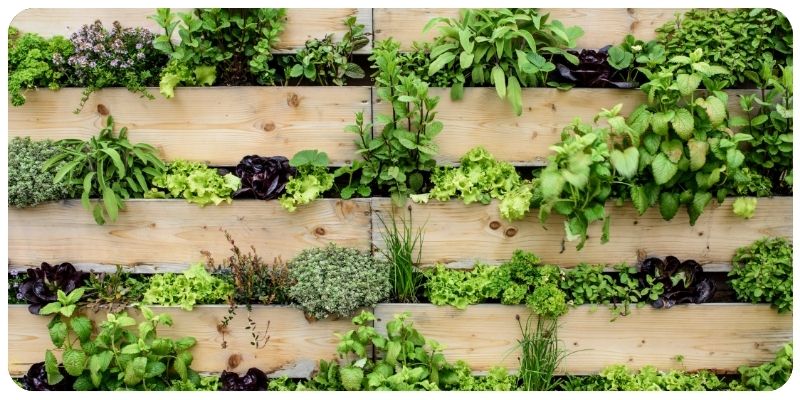
Maximizing Space: Vertical Gardening for Small Spaces
Living in small spaces doesn’t mean you have to give up on gardening. Vertical gardening is a brilliant solution for maximizing space, especially in urban settings or apartments. By using walls, fences, or specially designed vertical planters, you can create lush, thriving gardens even in the smallest of areas. In this guide, we’ll explore how to set up a vertical garden, the best plants for vertical growth, and tips to ensure your garden thrives in limited space.
1. Why Vertical Gardening?
Vertical gardening is an innovative approach to gardening that allows you to grow plants upward rather than outward. This technique is ideal for balconies, small backyards, and indoor spaces with limited room. It also adds a stunning visual element to your home or garden space, creating a green wall of vibrant plants. Plus, vertical gardens can improve air quality and provide insulation, reducing your home’s energy needs.
2. Choosing the Right Structure for Vertical Gardening
The first step to starting a vertical garden is selecting the right structure. You can purchase premade vertical garden systems, or you can build your own with simple materials. Here are some popular options:
Vertical Garden Structures
- Wall Planters: These are small containers attached to a wall or fence. They come in different materials, such as plastic, ceramic, or wood, and are perfect for herbs, succulents, or small flowers.
- Trellises: A trellis is a simple vertical structure made of wood or metal that supports climbing plants such as tomatoes, peas, or ivy. You can lean a trellis against a wall or install it freestanding.
- Pocket Planters: These fabric-based systems have pockets where you can grow herbs, flowers, or leafy greens. They are lightweight, easy to install, and ideal for indoor or outdoor use.
- Hanging Baskets: Hanging planters allow you to grow trailing plants such as pothos, strawberries, or cherry tomatoes. These are great for maximizing vertical space in balconies or patios.
3. Best Plants for Vertical Gardening
Not all plants are suitable for vertical gardening. For a successful vertical garden, it’s important to choose plants that thrive in small containers, climb, or cascade naturally. Here are some of the best plants for vertical gardening:
Top Plants for Vertical Gardens
- Herbs: Basil, mint, oregano, thyme, and parsley are great for vertical gardens. They are compact, easy to grow, and perfect for culinary use.
- Succulents: Succulents like echeveria, sedum, and jade plants are low-maintenance and thrive in vertical wall planters.
- Climbing Plants: Beans, peas, cucumbers, and climbing flowers such as jasmine or morning glory are excellent for trellises.
- Leafy Greens: Lettuce, spinach, and kale grow well in small containers and vertical pockets.
- Trailing Plants: Plants like pothos, spider plants, and strawberries work well in hanging baskets, creating a cascading effect.
4. How to Set Up a Vertical Garden
Setting up a vertical garden involves careful planning to ensure your plants get the right amount of light, water, and nutrients. Follow these steps to create your own vertical garden:
Steps to Set Up a Vertical Garden
- Select a Location: Choose a spot that gets the right amount of light for the plants you’re growing. For most vegetables and herbs, full sunlight is ideal.
- Install the Structure: Secure your vertical garden structure to a wall, fence, or railing. Make sure it is stable enough to support the weight of the plants and soil.
- Choose Your Plants: Select plants that will thrive in the vertical garden setup. Consider mixing different types of plants for a visually interesting and productive garden.
- Planting: Use lightweight potting soil and plant your chosen greenery into the containers, pockets, or baskets.
- Watering and Maintenance: Water your vertical garden regularly, but be careful not to overwater, as excess moisture can lead to root rot in confined spaces. Regularly check the structure for stability and adjust as needed.
5. Tips for Maintaining a Vertical Garden
Once your vertical garden is set up, ongoing care is essential to ensure it thrives. Here are some expert tips for maintaining a healthy vertical garden:
Maintenance Tips
- Water Wisely: Vertical gardens tend to dry out faster than traditional gardens. Use drip irrigation systems or self-watering planters to keep your plants hydrated.
- Prune Regularly: Keep plants trimmed to prevent overcrowding. This will help maintain airflow and allow light to reach all parts of the garden.
- Fertilize: Add slow-release fertilizer to your vertical garden to ensure that your plants get the nutrients they need for growth.
- Check for Pests: Regularly inspect your vertical garden for signs of pests or diseases. Use organic pest control methods when necessary.
Conclusion
Vertical gardening offers a space-efficient solution for small spaces, allowing you to grow a variety of plants even if you don’t have a large yard or garden. With the right setup, plant selection, and care, your vertical garden can thrive and bring beauty and productivity to your home. Whether you're growing fresh herbs, flowers, or vegetables, vertical gardening is a creative way to enjoy the benefits of gardening in a compact space.